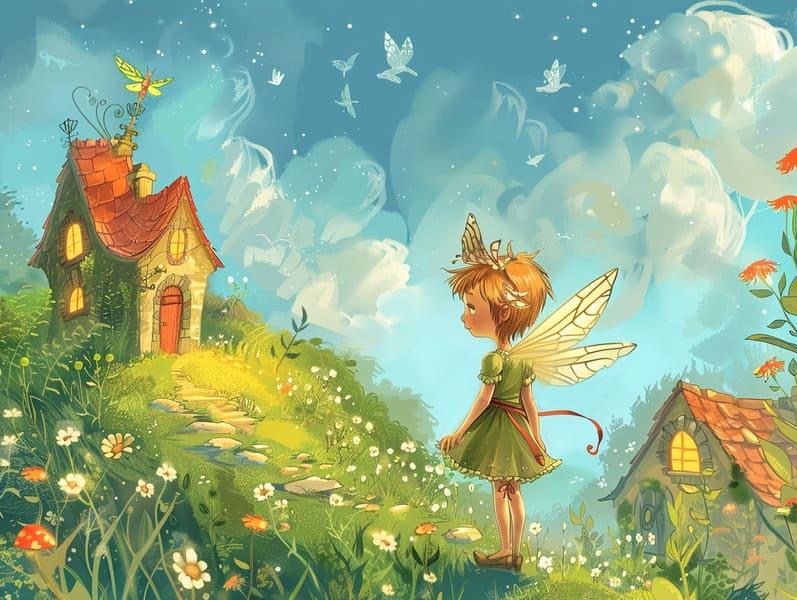
Traditional fairy tales have deep roots. These narratives have been told from one generation to the next millennia before they were ever inscribed. They sprang from a variety of societies, including Asian traditions. They were initially transmitted among grown-ups, often carrying themes and messages pertaining to the societal norms and beliefs of the time.
The Brothers Grimm, Jacob and Wilhelm Grimm, were among the first to collect and release many of these beloved tales. Their compilation, "Grimm's Fairy Stories," included narratives like "The Little Glass Slipper," "The Story of Hansel and Gretel," and "Little Snow White," which have since become hallmarks in the world of traditional fairy tales. Similarly, Hans Andersen's whimsical stories, such as "The Mermaid," and "The Duckling's Story," have enchanted hearts worldwide, guaranteeing their place in the pantheon of treasured fairy tales.
Even though they are old, these tales remain as applicable as ever, especially as children's night stories. These charming stories are now available in various formats, including colorful picture books, charming animations, and free fairy tales online.
Their enduring popularity can be ascribed to several captivating elements:
Life Lessons: Timeless fairy tales often whisper important moral lessons. Tales like "The Wolf and the Liar" teach the virtue of honesty, while "The Tale of the Tortoise and the Hare" illustrate the virtues of resolve and humility. These narratives offer young ones clear distinctions between virtue and vice, building their moral compass in a tender yet profound way.
Kindness and Comprehension: Timeless fairy tales frequently showcase beings facing difficulties and adversities, inciting young listeners to connect with their struggles and root for their triumphs. For instance, "The Story of Beauty and the Beast" conveys the benefit of looking beyond appearances to comprehend the real person of a individual, strengthening perception and awareness.
Cultural Knowledge: Many fairy tales are rich in the cultural contexts from which they grew. Engaging with these fairy tales can provide delightful insights into different historical contexts, building a sense of cultural insight and respect.
Imagination and Creativity: The fantasy-filled elements in timeless fairy tales—magic wands—boost children’s imaginations. These tales guide readers to supernatural realms, stimulating inventive ideas and a sense of wonder that lasts a lifetime.
Timeless fairy tales are not only spellbinding but also edifying. They act as charming tools in promoting various mental and emotional abilities in little ones. When traditional fairy tales are spoken out loud, they develop verbal development by bringing new terms and meanings and complicated sentence structures. This practice also strengthens hearing perception and concentration, as children stay focused, keen to see what happens next.
Furthermore, conversing about the themes and characters of old fairy tales can advance evaluative skills and thinking skills. Young readers are led to pinpoint patterns, make predictions, and catch on to cause and effect. These conversations also ease children reveal their thoughts and feelings, contributing to their emotional intelligence.
In today’s modern era, the presence of online fairy tales has made these narratives more attainable than ever. Digital sites and mobile apps give extensive collections of Grimm's fairy tales that can be browsed or played anytime, anywhere. Fairy tales spoken are particularly well-received, offering an enjoyable way for the young to engage with these charming stories. Narrated books and spoken videos guide characters and settings to life, often supported by fantastical sound effects and soundtracks that boost the tale journey.
The timeless check it out allure of old fairy tales lies in their ability to adjust to contemporary times while keeping hold of their fundamental ideas. Contemporary renditions of these tales often incorporate more different protagonists and modern settings, making them accessible to today’s audience. However, the fundamental themes of gallantry, kindheartedness, and fairness remain unchanged, continuing to reach children of all ages.
Traditional fairy tales also offer a sense of reassurance and understanding. They afford a organized narrative with a obvious beginning, middle, and end, often wrapping up with the wrap-up of conflicts and the triumph of virtue over corruption. This constancy can be reassuring for young readers, imparting a sense of sturdiness in an fluid world.
Traditional fairy tales continue to captivate and enlighten new generations, maintaining their charm and relevance in modern society. As kids' bedtime tales, they afford a perfect blend of fantasy and learning, cultivating moral values, empathy, and creativity. The proliferation of internet fairy tales and the sought after status of fairy tales read out loud validate that these old narratives remain attainable to new generations.
By keeping and conveying these tales, we continue to value the rich tapestry of legends and cultural heritage. Whether you are discovering a beautifully illustrated book, seeing a web-based library, or listening through an audiobook, the enchantment of classic fairy tales is always within reach. These narratives remind us of the timeless magic of narratives and its ability to link us across epochs and places.
Whether you are exploring a vibrantly illustrated book, perusing a online collection, or listening via an read-aloud story, the allure of famous fairy tales is always within reach.
These fairy tales show us of the timeless ability of stories and its ability to tie us across generations and cultures, weaving a spell that delights and instructs alike.